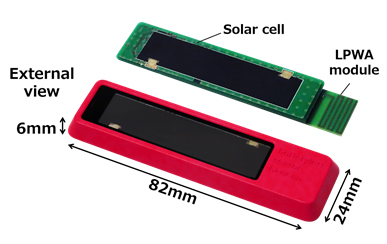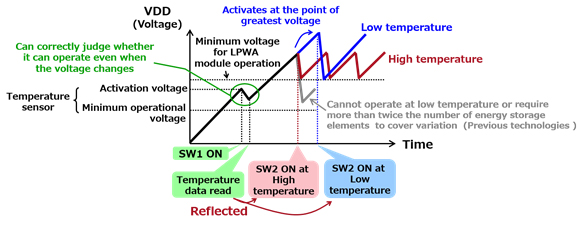Fujitsu Laboratories has developed the world's smallest sensor that eliminates the need to replace batteries. The new sensor supports Low Power Wide Area (LPWA) wireless transmission technology that can reach a broad area with low power via a solar cell source.
The technology controls signal transmission timing based on the temperature variation measured by a temperature sensor, which makes it possible to reduce the required energy storage elements for signal transmission by half. This has enabled Fujitsu Laboratories to successfully miniaturise the device to 82 x 24 x 6 mm, creating the world's smallest sensor device supporting LPWAN that does not need replacement batteries.
In a test of the sensor device using this technology, Fujitsu Laboratories confirmed that the collected temperature and humidity data can be transmitted to a Sigfox base station over a distance of about 7 km. Since it is now possible to acquire measured data even from locations where it is difficult to secure power and install power cables just by placing these sensor devices, the maintenance-free deployment and management of IoT systems has become a reality.

In a test of the sensor device using this technology, Fujitsu Laboratories confirmed that the collected temperature and humidity data can be transmitted to a Sigfox base station over a distance of about 7 km. Since it is now possible to acquire measured data even from locations where it is difficult to secure power and install power cables just by placing these sensor devices, the maintenance-free deployment and management of IoT systems has become a reality.

Fujitsu Laboratories has previously developed power control technology using miniature circuits that can transmit data over short distances wirelessly using Bluetooth Low Energy (BLE). Sensor devices using BLE however could not support LPWAN as the time required for transmission with LPWAN is significantly longer than with BLE. LPWAN transmits small amounts of data slowly in order to ensure signal quality over long distances. In effect, this means that a single transmission can require significant power usage of up to about 1,500 times of BLE.
Now, Fujitsu Laboratories has developed new power control technology to ensure transmission power while minimising circuit size.
 Figure 2: Circuit diagram for the newly developed sensor device
Figure 2: Circuit diagram for the newly developed sensor device
Now, Fujitsu Laboratories has developed new power control technology to ensure transmission power while minimising circuit size.
 Figure 2: Circuit diagram for the newly developed sensor device
Figure 2: Circuit diagram for the newly developed sensor device
The power control technology that can control the timing of LPWA signal transmissions in real time, based on temperature data collected from a temperature sensor. With this technology signal transmissions are only carried out at the time when the activation voltage, which varies with temperature, is maximised in order to prevent it from falling below the minimum operational voltage for LPWA module.
By using power efficiently in this way, it is possible to tolerate variation in power consumed by the wireless circuit or power generated by solar cells due to temperature. This eliminates the need for the excess energy storage elements that were previously necessary to respond to power fluctuations, enabling miniaturisation of the sensor device with the smallest power storage elements required.
 Figure 3: Chart of operational timing
Figure 3: Chart of operational timing
 Figure 3: Chart of operational timing
Figure 3: Chart of operational timing
The technology was implemented using Sigfox, verifing that temperature and humidity data could be transmitted once every ten minutes, over seven days directly to a base station about 7 km away, in an environment with illumination of 4,000 lux. Fujitsu Laboratories also showed that the data could be visualized through the Fujitsu Cloud Service K5 IoT Platform, which has received Sigfox Ready Program for IoT PaaS certification as an IoT platform that connects to the Sigfox cloud.
This means that sensor data can easily be acquired in the cloud just by setting sensor devices, even in places where it is difficult to secure power or install power cables. This will enable maintenance-free installation and management of IoT systems, accelerating the process of digitalization in the field.
Fujitsu Laboratories will continue to conduct field trials aimed at the real-world use of these sensor devices, incorporating this technology into the Fujitsu Cloud Service K5 IoT Platform and Fujitsu Frontech Limited's sensors.
This means that sensor data can easily be acquired in the cloud just by setting sensor devices, even in places where it is difficult to secure power or install power cables. This will enable maintenance-free installation and management of IoT systems, accelerating the process of digitalization in the field.
Fujitsu Laboratories will continue to conduct field trials aimed at the real-world use of these sensor devices, incorporating this technology into the Fujitsu Cloud Service K5 IoT Platform and Fujitsu Frontech Limited's sensors.
Related stories:
- Laird moves up the IoT value chain with LoRa gateway
- STMicroelectronics teams with Objenious to speed up IoT nodes development for LoRa networks
- Arkessa teams with telent for German LPWAN IoT network

No comments:
Post a Comment